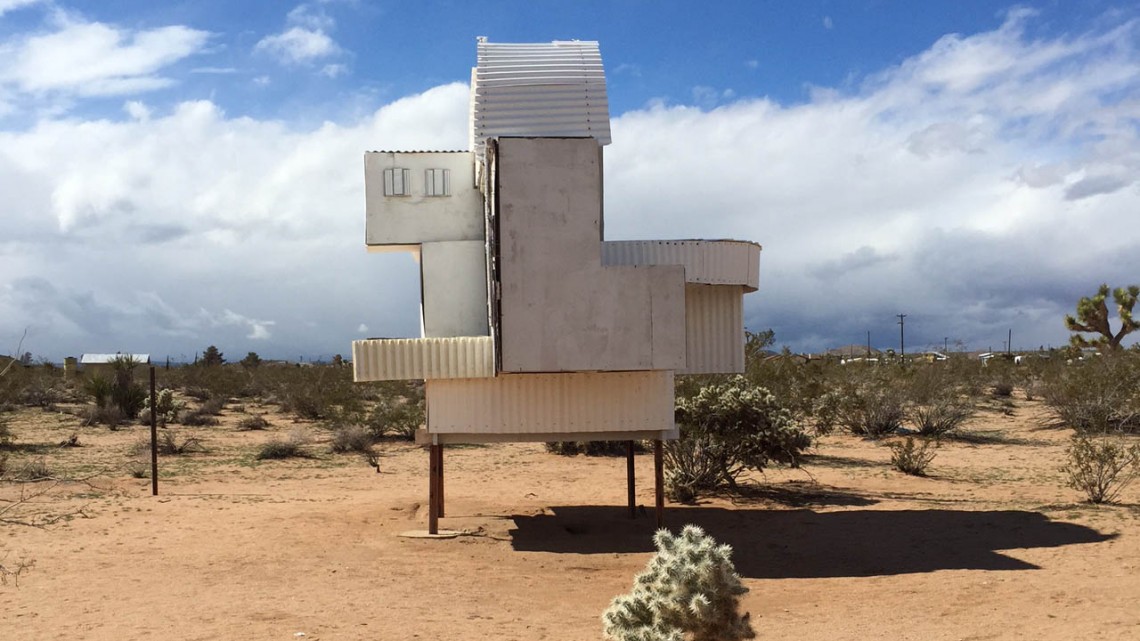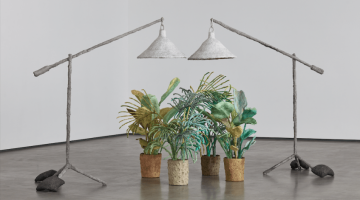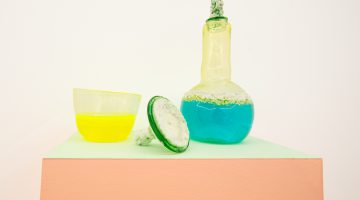Noah Purifoy: Junk Dada
Curated by Franklin Sirmans and Yael Lipschutz
June 7 – September 27, 2015
(Second iteration of exhibition: October 10, 2015-January 3, 2016.)
LACMA
5905 Wilshire Blvd, Los Angeles, CA 90036
“You will need to look hard and think deeply to grasp the messages [in these works] . . . it took hard work and struggle to produce them, and it is hard work to understand them. But so it is, with most worthwhile things.” —Noah Purifoy, in a press release for a 1971 installation
There is surely a lot to be said about Noah Purifoy’s work from a formal standpoint. I’m not the writer to say it. It’s not just the materials he used that matters, but also the ways he combined them—the patterns and compositions, the colors and textures. I don’t know enough about that to offer more than what is obvious in the title of the wonderful Purifoy retrospective currently at LACMA, Junk Dada: the pieces are made of repurposed everyday objects, often mis-known as “junk”. The form is assemblage, one of the Dadaists’ key innovations. (Rubén Martinez has covered more of the formal ground here.)
I feel somewhat better equipped to write about content, and context.
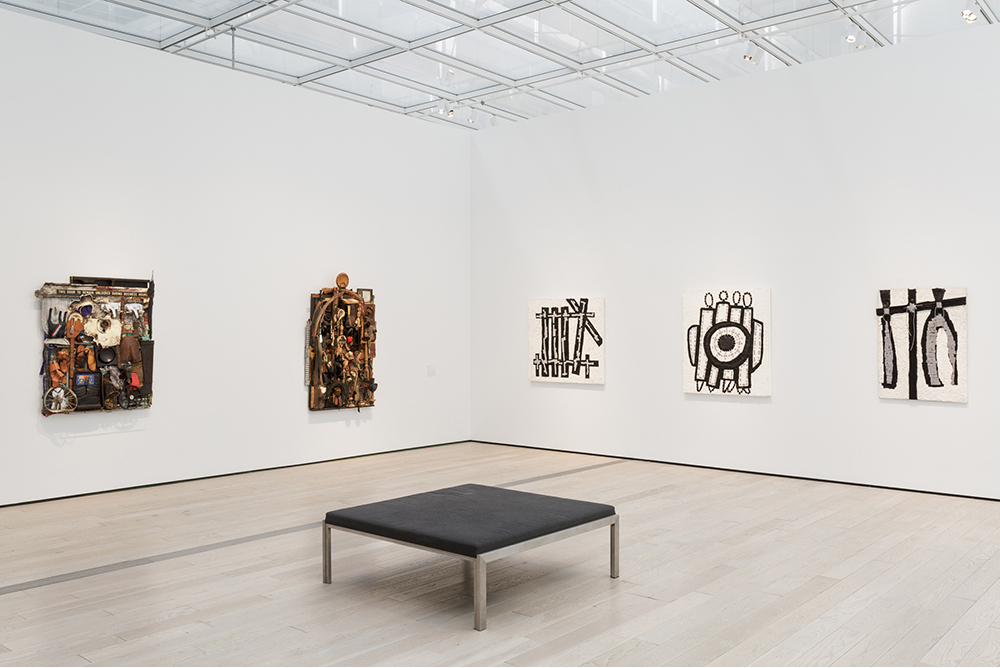
Installation photo of the exhibition “Noah Purifoy: Junk Dada” at the Los Angeles County Museum of Art. June 07- September 27, 2015. ©Noah Purifoy Foundation. Photo © Museum Associates/LACMA
Purifoy was born in the Jim Crow South in 1917. He moved to Los Angeles in the early 1950s to attend Chouinard Art Institute (now CalArts), where he was the first full-time black student. In 1965, the Watts Rebellion erupted in LA in protest against racist police violence. Over the next few months, Purifoy and Judson Powell curated 66 Signs of Neon, a group show of artworks made of charred wood and melted objects salvaged from the fires of that rebellion. From that show on, Purifoy would be salvaging, reusing, transforming, and communicating about the world he lived in.
He did these things through his own art practice and through community work. Beyond curating group shows, he co-founded the Watts Towers Arts Center, prioritizing youth arts education and exhibitions of contemporary art, and for most of the ’70s, he served on the California Arts Council, getting art into prisons, among other efforts.
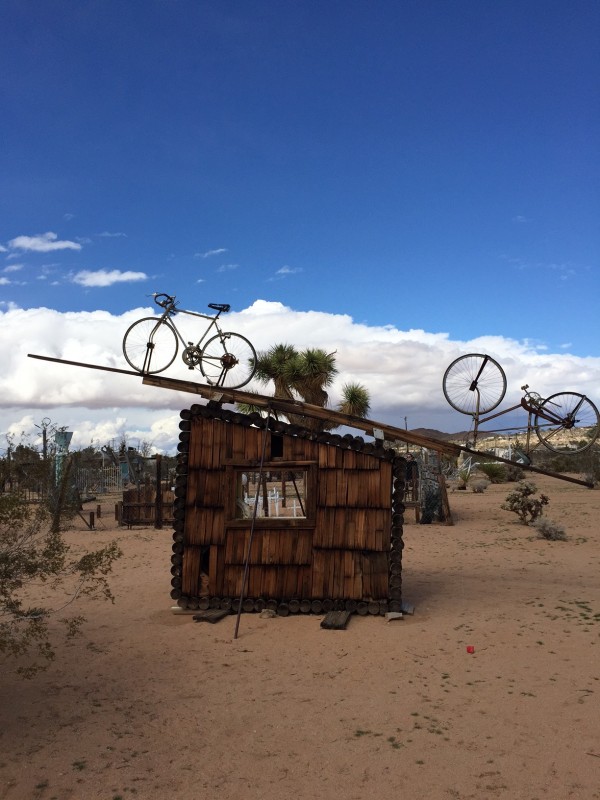
Noah Purifoy Outdoor Desert Art Museum. Photo by Jessica Hoffmann.
There’s a powerful narrative in modern art history about the lone genius who goes off into the middle of nowhere to make his work, freed from the art world or society or any kind of social context, and there’s a whiff of this story in some accounts of Noah Purifoy, who in 1989, in his early 70s, moved to the desert in Joshua Tree, where he built a large body of sculptures that are now installed throughout the landscape in the Noah Purifoy Outdoor Desert Art Museum. The problem is, it’s a colonial myth (unsurprisingly, one most frequently attached to white men)—in reality, there’s no “nowhere,” no artist is a lone ranger disconnected from social context, etc. And the particular problem with applying that myth to Purifoy is that he didn’t take off to Joshua Tree in some driving lust for artistic freedom. He moved to Joshua Tree because he could no longer afford rent in LA, and a friend out there had offered him a place to live. Once there, he made art where he was.
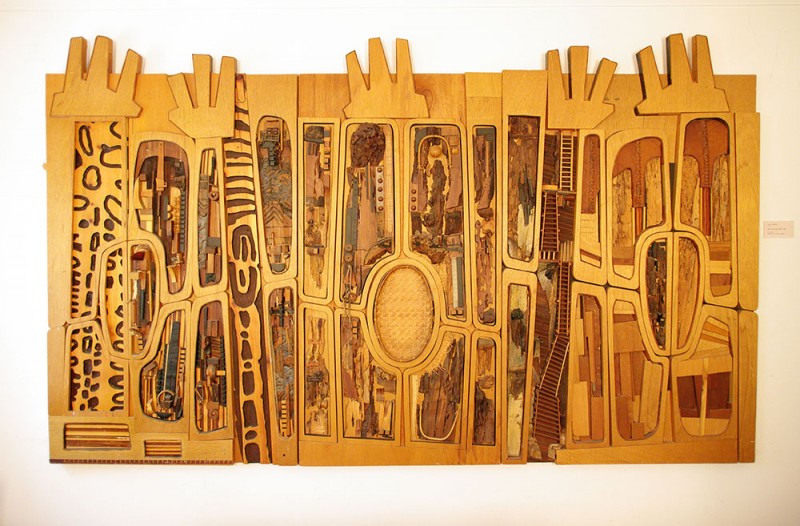
Noah Purifoy. “Black, Brown and Beige (After Duke Ellington),” 1989. 68 x 113 in. Sue A. Welsh Collection. © Noah Purifoy Foundation. Photo courtesy Noah Purifoy Foundation, by Seamus O’ Dubslaine
Many of the pieces in the LACMA show have been brought to the indoor museum from their desert home. In addition to Purifoy’s assemblage works, the expansive LACMA retrospective contains two rooms devoted to his community work. One contains documents of his time as a sort of community curator and director of a public arts center—flyers, programs, newspaper clippings. They offer important glimpses into the history of political art in Los Angeles, the intersections between art making and community work, and some of Purifoy’s specific concerns. An artist’s statement from 1971 reads, “The artist who reclaims unwanted things is not unique. This is one of the basic necessities of the poor. But the poor seldom understand art as art is interpreted by the white culture.” Toward the end of the multi-room exhibition is a room full of pieces from 66 Signs of Neon (the Watts Rebellion group show), a soul-stirring punch from the archives in this moment of continued police violence against black people and the Black Lives Matter movement that has risen in response to it.
It is, of course, two different experiences to see Purifoy’s works in his Outdoor Desert Art Museum and in the Broad Contemporary building at LACMA. While both spaces have a sense of expanse, where the desert museum is all dirt and elements, the galleries are dustless, weatherless. But the signs of weather (political and meteorological) are all over Purifoy’s works, wherever they are hung or standing. And the recognition and accessibility occasioned by the LACMA show are important.
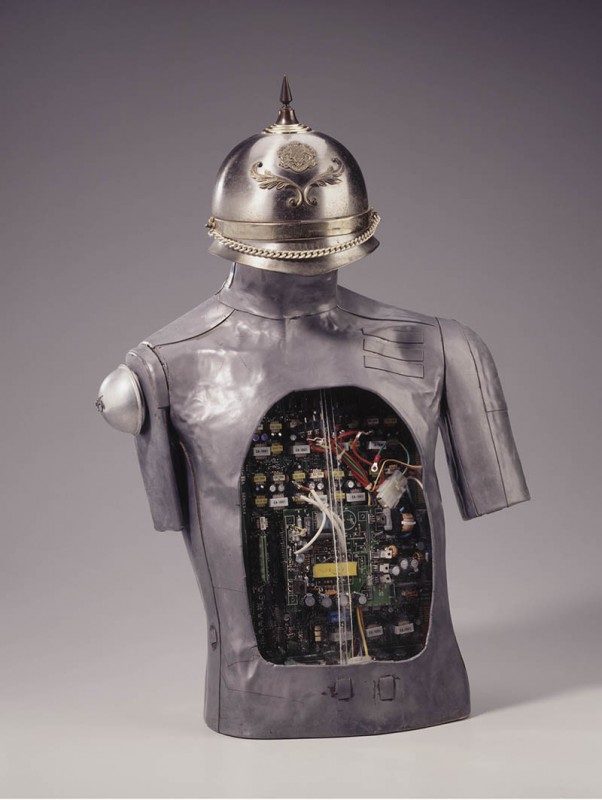
Noah Purifoy. “Sir Watts II,” 1996. Assemblage sculpture. Collection of the Oakland Museum of California, gift of the Collector’s gallery © Noah Purifoy Foundation. Photo © Oakland Museum of California, all rights reserved.
Under her cap as director of the William Grant Still Arts Center, a municipal facility not unlike the Watts Towers Arts Center that Purifoy co-founded, artist Amitis Motevalli brought more than 30 children and youth to the Junk Dada show this summer. The kids loved the show for its use of recognizable objects and its “poetic simplicity,” she said. “I find his work similar to Sufi poetry, where you read and you’re like, ‘This is so simple, I could have written this.’ But it has a different reverberation and complexity.”
At one point a group of kids clustered in front of Purifoy’s Strange Fruit, a mass of white feathers stuck together atop a rectangle of black-painted boards, from which hangs a can of black paint and a paintbrush. A young group leader asked the kids what they thought of it. “Someone just decided to paint black.” “I don’t know, these feathers.” The comments started simple, light and overlapping. But then a security guard approached and said, “This is a very important part of our history. You need to look at this. You need to look hard.” At which point one kid said, “I know what it is.” A conversation ensued about tarring and feathering. (“Strange Fruit” is a haunting reference to lynching, in a phrase borrowed from a poem by Abel Meeropol and popularized by a Billie Holiday song.)
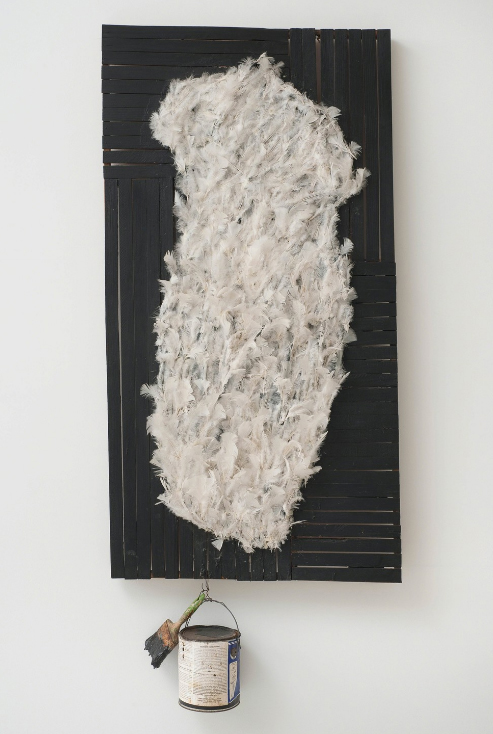
Noah Purifoy. “Strange Fruit,” 2002. 74 x 31.5 x 6.5 in. Sue A. Welsh Collection
© Noah Purifoy Foundation. Photo © Robert Wedemeyer
In addition to working on her own art—a recent project entailed flying kites bearing portraits of people who have been killed by police—at the Center, Motevalli is organizing a show drawn from un-institutionalized neighborhood collections of black LGBT history and black radical movement art. She points out that the neighborhood where the Center is located is being gentrified. “This is a neighborhood that pushed forth lawsuits that were able to break covenants [racist exclusionary land-use laws]. This is a neighborhood where the homes of Japanese Americans were taken from them when they were interned. The neighborhood has a very significant history of land heist and discrimination,” she said. Senior artists involved with the William Grant Still Arts Center are doing public performances to intervene. “We are doing work to remember and honor folks who were here before and not let that happen again.” In an era when community-rooted, social-justice-minded art making has been largely co-opted by “social practice,” it’s heartening to know the Noah Purifoy legacy is alive in Los Angeles.
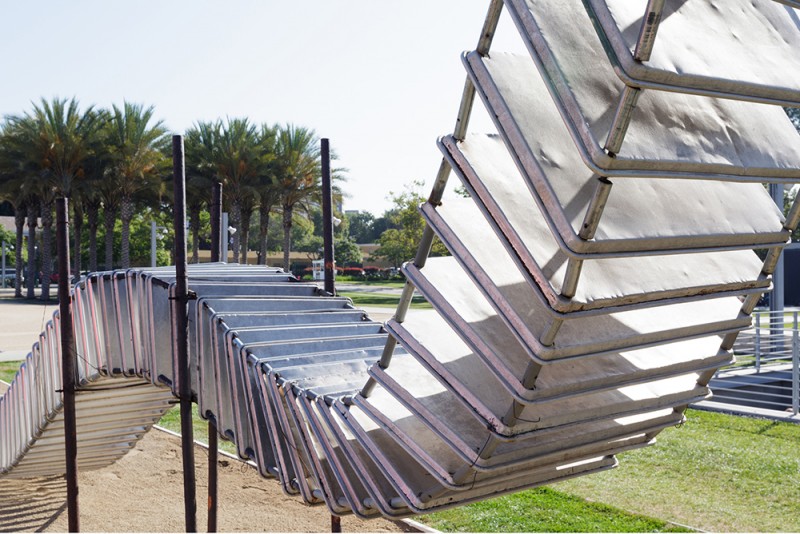
Detail of Noah Purifoy’s “65 Aluminum Trays,” 2002. Installed at the Los Angeles County Museum of Art (LACMA) for the exhibition “Noah Purifoy: Junk Dada”. June 07- September 27, 2015. ©Noah Purifoy Foundation. Photo © Museum Associates/LACMA
Those seeking a similar intertwining of art, community, and social justice in the Bay Area might look to POOR Magazine, an arts and media organization that was recently gentrified out of San Francisco, but is blossoming with relentless prolificity across the bay. Not only does the poor-people-led non-profit publish hybrid journalism/creative writing by people struggling in poverty, they do interventions on colonialism-inflected shows at the De Young, teach art (and a lot of other things) to kids, and are in the process of building revolutionary co-housing for houseless and formerly houseless people at a space called Homefulness in East Oakland.
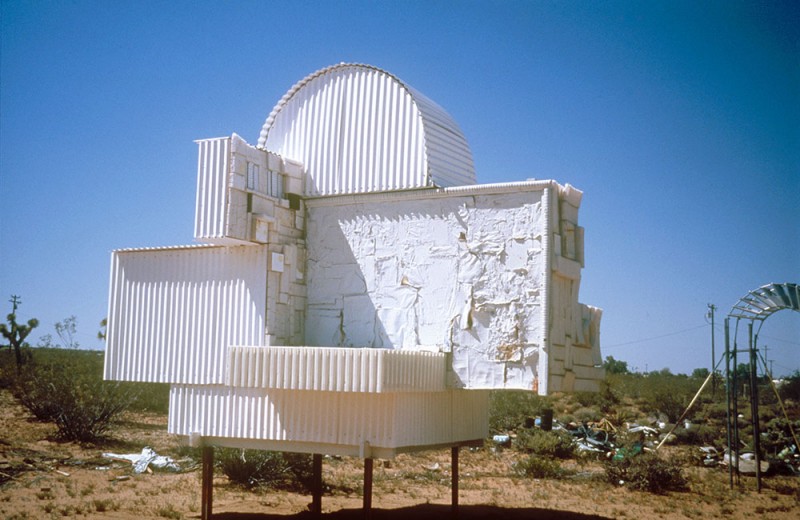
Noah Purifoy Outdoor Desert Art Museum. Photo by Jessica Hoffmann.
Noah Purifoy wrote, in one of the early artist statements displayed in the LACMA retrospective: “We as artists do not claim to have the solution to the problem but the question remains who is responsible for this kind of poverty in the midst of plenty.” The question remains still. Meanwhile, Noah Purifoy is one answer to who is responsible for a kind of abundance—of vision, of engagement, of commitment, of creativity, of love—in this midst.
